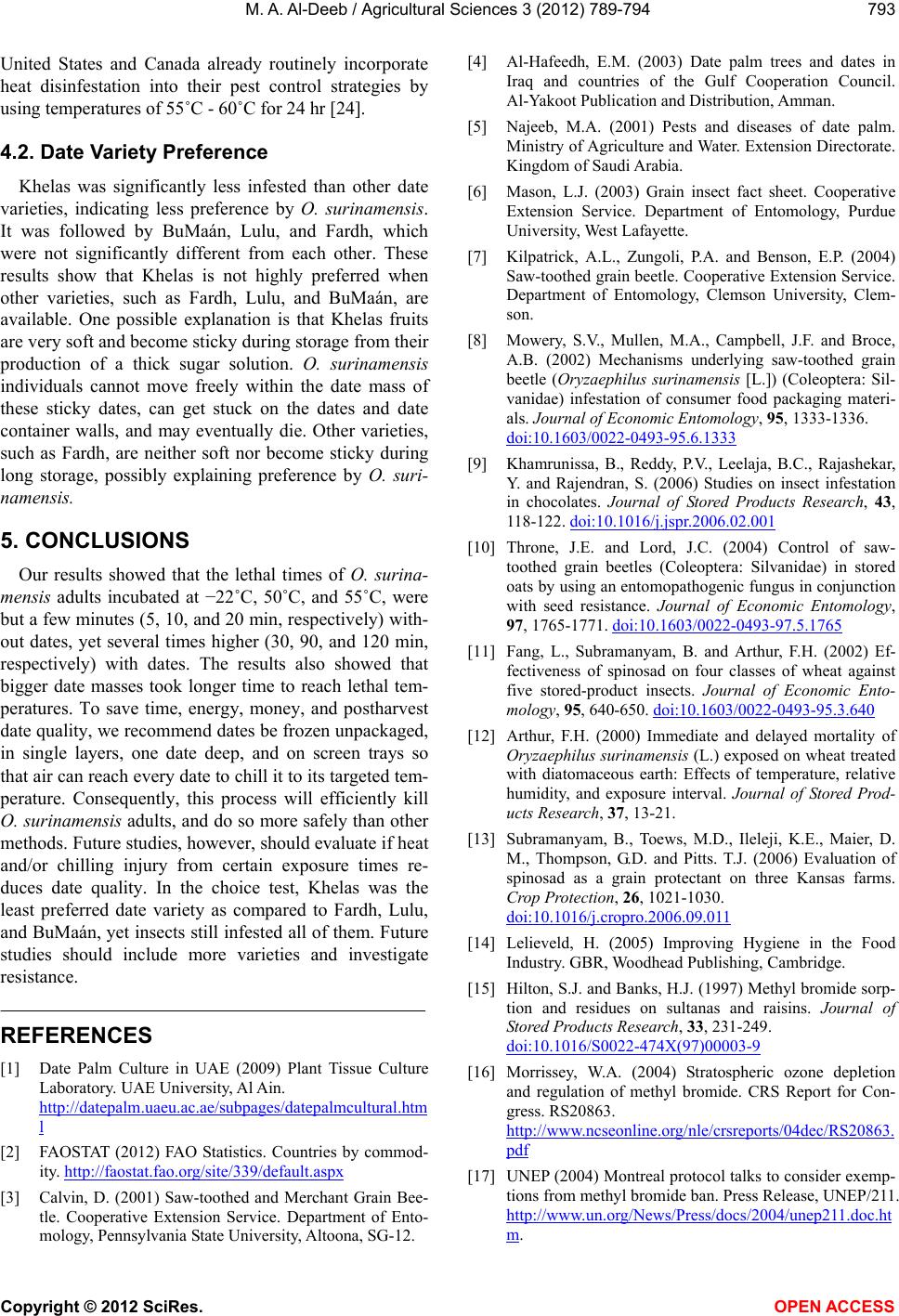
M. A. Al-Deeb / Agricultural Sciences 3 (2012 ) 789-794 793
United States and Canada already routinely incorporate
heat disinfestation into their pest control strategies by
using temperatures of 55˚C - 60˚C for 24 hr [24].
4.2. Date Variety Preference
Khelas was significantly less infested than other date
varieties, indicating less preference by O. surinamensis.
It was followed by BuMaán, Lulu, and Fardh, which
were not significantly different from each other. These
results show that Khelas is not highly preferred when
other varieties, such as Fardh, Lulu, and BuMaán, are
available. One possible explanation is that Khelas fruits
are very soft and become sticky during storage from their
production of a thick sugar solution. O. surinamensis
individuals cannot move freely within the date mass of
these sticky dates, can get stuck on the dates and date
container walls, and may eventually die. Other varieties,
such as Fardh, are neither soft nor become sticky during
long storage, possibly explaining preference by O. suri-
namensis.
5. CONCLUSIONS
Our results showed that the lethal times of O. surina-
mensis adults incubated at −22˚C, 50˚C, and 55˚C, were
but a few minutes (5, 10, and 20 min, respectively) with-
out dates, yet several times higher (30, 90, and 120 min,
respectively) with dates. The results also showed that
bigger date masses took longer time to reach lethal tem-
peratures. To save time, energy, money, and postharvest
date quality, we recommend dates be frozen unpackaged,
in single layers, one date deep, and on screen trays so
that air can reach every date to chill it to its targeted tem-
perature. Consequently, this process will efficiently kill
O. surinamensis adults, and do so more safely than other
methods. Future studies, however, should evaluate if heat
and/or chilling injury from certain exposure times re-
duces date quality. In the choice test, Khelas was the
least preferred date variety as compared to Fardh, Lulu,
and BuMaán, yet insects still infested all of them. Future
studies should include more varieties and investigate
resistance.
REFERENCES
[1] Date Palm Culture in UAE (2009) Plant Tissue Culture
Laboratory. UAE University, Al Ain.
http://datepalm.uaeu.ac.ae/subpages/datepalmcultural.htm
l
[2] FAOSTAT (2012) FAO Statistics. Countries by commod-
ity. http://faostat.fao.org/site/339/default.aspx
[3] Calvin, D. (2001) Saw-toothed and Merchant Grain Bee-
tle. Cooperative Extension Service. Department of Ento-
mology, Pennsylvania State University, Altoona, SG-12.
[4] Al-Hafeedh, E.M. (2003) Date palm trees and dates in
Iraq and countries of the Gulf Cooperation Council.
Al-Yakoot Publication and Distribution, Amman.
[5] Najeeb, M.A. (2001) Pests and diseases of date palm.
Ministry of Agriculture and Water. Extension Directorate.
Kingdom of Saudi Arabia.
[6] Mason, L.J. (2003) Grain insect fact sheet. Cooperative
Extension Service. Department of Entomology, Purdue
University, West Lafayette.
[7] Kilpatrick, A.L., Zungoli, P.A. and Benson, E.P. (2004)
Saw-toothed grain beetle. Cooperative Extension Service.
Department of Entomology, Clemson University, Clem-
son.
[8] Mowery, S.V., Mullen, M.A., Campbell, J.F. and Broce,
A.B. (2002) Mechanisms underlying saw-toothed grain
beetle (Oryzaephilus surinamensis [L.]) (Coleoptera: Sil-
vanidae) infestation of consumer food packaging materi-
als. Journal of Economic Entomology, 95, 1333-1336.
doi:10.1603/0022-0493-95.6.1333
[9] Khamrunissa, B., Reddy, P.V., Leelaja, B.C., Rajashekar,
Y. and Rajendran, S. (2006) Studies on insect infestation
in chocolates. Journal of Stored Products Research, 43,
118-122. doi:10.1016/j.jspr.2006.02.001
[10] Throne, J.E. and Lord, J.C. (2004) Control of saw-
toothed grain beetles (Coleoptera: Silvanidae) in stored
oats by using an entomopathogenic fungus in conjunction
with seed resistance. Journal of Economic Entomology,
97, 1765-1771. doi:10.1603/0022-0493-97.5.1765
[11] Fang, L., Subramanyam, B. and Arthur, F.H. (2002) Ef-
fectiveness of spinosad on four classes of wheat against
five stored-product insects. Journal of Economic Ento-
mology, 95, 640-650. doi:10.1603/0022-0493-95.3.640
[12] Arthur, F.H. (2000) Immediate and delayed mortality of
Oryzaephilus surinamensis (L.) exposed on wheat treated
with diatomaceous earth: Effects of temperature, relative
humidity, and exposure interval. Journal of Stored Prod-
ucts Research, 37, 13-21.
[13] Subramanyam, B., Toews, M.D., Ileleji, K.E., Maier, D.
M., Thompson, G.D. and Pitts. T.J. (2006) Evaluation of
spinosad as a grain protectant on three Kansas farms.
Crop Protection, 26, 1021-1030.
doi:10.1016/j.cropro.2006.09.011
[14] Lelieveld, H. (2005) Improving Hygiene in the Food
Industry. GBR, Woodhead Publishing, Cambridge.
[15] Hilton, S.J. and Banks, H.J. (1997) Methyl bromide sorp-
tion and residues on sultanas and raisins. Journal of
Stored Products Research, 33, 231-249.
doi:10.1016/S0022-474X(97)00003-9
[16] Morrissey, W.A. (2004) Stratospheric ozone depletion
and regulation of methyl bromide. CRS Report for Con-
gress. RS20863.
http://www.ncseonline.org/nle/crsreports/04dec/RS20863.
pdf
[17] UNEP (2004) Montreal protocol talks to consider exemp-
tions from methyl bromide ban. Press Release, UNEP/211.
http://www.un.org/News/Press/docs/2004/unep211.doc.ht
m.
Copyright © 2012 SciRes. OPEN ACCESS